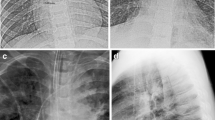Abstract
Frontal chest radiographs can be misleading in the evaluation of central venous catheter placement. Lateral chest radiographs were obtained, in addition to the standard frontal radiographs, in 25 young children. In five (20%) of the children, the catheters were found to be malpositioned, and the frontal radiograph showed evidence of the abnormality in all five. The lateral radiographs also showed evidence of the abnormality in all five children; however, in three of the five, the lateral radiographs provided additional, more specific, diagnostic information. The lateral chest radiographs also demonstrated satisfactory catheter positioning in three other children in whom the frontal radiographs suggested abnormal positioning. Accurate assessment of catheter position was possible in all patients using both frontal and lateral chest radiographs. Injection of contrast material was not necessary to locate malpositioned cathethers. Lateral radiographs are recommended whenever an abnormal catheter position is suspected clinically or from findings on the routine frontal radiograph.
Similar content being viewed by others
References
Cohen MD (1980) Tubes wires [sic] and the neonate. Clin Radiol 31:249
Deitel M, McIntyre JA (1971) Radiographic confirmation of site of central venous pressure catheters. Canad J Surg 14, 42
Dunbar RD, Mitchell R, Lavine M (1981) Aberrant locations of central venous catheters. Lancet 1:711
Gilday DL, Downs AR (1969) The value of chest radiography in the localization of central venous pressure catheters. Canad Med Assoc J 101:363
Jacobsen WK, Smith DC, Briggs BA, Dunbar RD (1979) Aberrant catheter placement for total parenteral nutrition. Anesthesiology 50:152
Kellner GA, Smart JF (1971) Percutaneous placement of catheters to monitor “central venous pressure”. Anesthesiology 36:515
Krausz MM, Berlatzky J, Eimerl D, Cotev S (1978) Aberrant position of a central venous catheter: A cause for inadequate fluid replacement in septic shock. Crit Care Med 6:337
Langston CS (1971) The aberrant central venous cacheter and its complications. Radiology 100:55
Malatinský J, Kadlic T, Májek M, Sámel M (1976) Misplacement and loop formation of central venous catheters. Acta Anaesth Scand 20:237
McGoon MD, Benedetto PW, Greene BM (1979) Comptications of percutaneous central venous catheterization: A report of two cases and review of the literature. Johns Hopkins Med J 135:1
Mitchell SE, Clark RA (1979) Complications of central venous catheterization. AJR 133:467
Ravin CE (1980) Catheter malposition (Letter to the Editor). AJR 134:619
Singleton EB (1981) Radiologic considerations of internsive care in the premature infant. Radiology 130:291
Author information
Authors and Affiliations
Additional information
Postdoctoral scholar, supported by NIH Research Grant 5T32CA 0938602
Rights and permissions
About this article
Cite this article
Stark, D.D., Brasch, R.C. & Gooding, C.A. Radiographic assessment of venous catheter position in children: value of the lateral view. Pediatr Radiol 14, 76–80 (1984). https://doi.org/10.1007/BF01625810
Accepted:
Issue Date:
DOI: https://doi.org/10.1007/BF01625810




